
 |
|
|
#1 |
|
Member
Join Date: Dec 2004
Location: What is still UK
Posts: 5,939
|
Some damned fool might have paid a lot of hongo for this. A fool and thier money are soon parted.
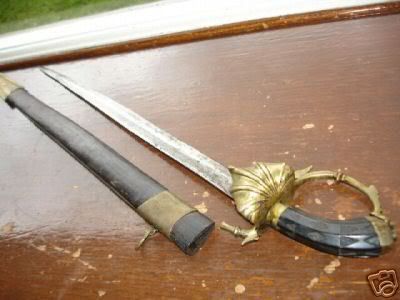 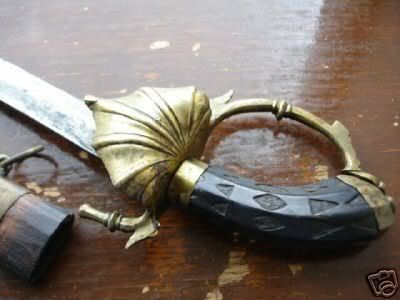 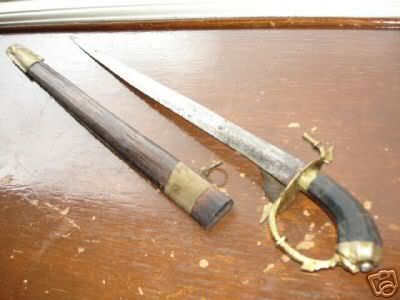 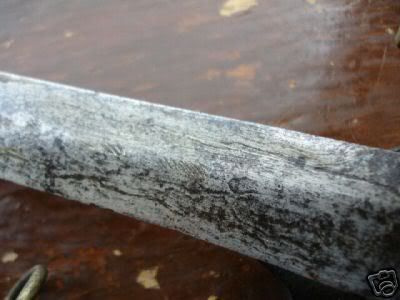
|
|
|

|
|
|
#2 |
|
Vikingsword Staff
Join Date: Nov 2004
Posts: 6,378
|
Something whispers 'Philippine' in my ear ....
  I wonder what the inlays were ? |
|
|

|
|
|
#3 |
|
Member
Join Date: Dec 2004
Posts: 755
|
MAYBE A INDONESIAN HUNTING SWORD?
Last edited by carlos; 12th July 2007 at 07:35 PM. Reason: MY BAD ENGLISH |
|
|

|
|
|
#4 |
|
Member
Join Date: Dec 2004
Location: What is still UK
Posts: 5,939
|
Must have been some bloody fool Englishman
 . .
|
|
|

|
|
|
#5 |
|
Member
Join Date: Dec 2004
Location: What is still UK
Posts: 5,939
|
Whoever bought it could easily stick come mother of pearl in the grip.

|
|
|

|
|
|
#6 |
|
Member
Join Date: Dec 2004
Location: The Netherlands
Posts: 1,209
|
If this object has a pamor blade then it is an Indonesian weapon. I think it is a pedang.
The grip had inlay. Could be very well mother of pearl. |
|
|

|
|
|
#7 | |
|
Member
Join Date: Dec 2004
Location: Virginia
Posts: 520
|
Quote:
|
|
|
|

|
|
|
#8 |
|
(deceased)
Join Date: Dec 2004
Location: OKLAHOMA, USA
Posts: 3,138
|
I AGREE IT IS PROBABLY A PEDANG THE WORKMANSHIP AND THE WAY THE GAURD IS ATTACHED REMINDS ME OF PRANG NABURS. PERHAPS IT IS A PEDANG WITH SOME EUROPEAN INFLUNCE IN THE DESIGN OF THE GUARD.
UNFORTUNATELY THESE TWO NABURS PICTURED ARE NOT MINE AND I DON'T REMEMBER WHERE I GOT THE PICTURES FOR REFRENCE SO I HOPE NO ONE IS OFFENDED BY THEIR USE HERE. 
|
|
|

|
|
|
#9 |
|
Member
Join Date: Dec 2004
Location: What is still UK
Posts: 5,939
|
Can anyone say whether silver pieces might have been used as inlay. Most often silver pieces are pinned in place. Here it looks as if the inlay was held in place by an adhesive which might suggest more likely mother of pearl?
|
|
|

|
|
|
#10 |
|
Vikingsword Staff
Join Date: Nov 2004
Posts: 6,378
|
It seems that all the inlay pieces are gone; this suggests to me that they had some monetary value; silver possibly but it might have been suassa or low carat gold .

|
|
|

|
|
|
#11 |
|
Member
Join Date: Dec 2004
Location: What is still UK
Posts: 5,939
|
Good point Rick. Working with it all the time I sometimes loose track that to some people it is precious. It will be far easier to replace than mother of pearl.
|
|
|

|
|
|
#12 |
|
EAAF Staff
Join Date: Dec 2004
Location: Louisville, KY
Posts: 7,363
|
I am in the Indonesian camp. I am thinking perhaps ivory inlays. These can fall out too.
|
|
|

|
|
|
#13 |
|
Member
Join Date: Dec 2004
Location: The Netherlands
Posts: 1,209
|
If the inlay was mother of pearl it is very good possible that the adhesive contains some remains of mother of pearl. I don't think the inlay was a metal like silver or gold or something. Metal inlay mostly was, as said, pinned. I personally have the idea that the inlay was made of an organic material like mother of pearl, bone or ivory. But why is all the inlay removed? Then the theory of silver or gold makes sense.
In the book by Van Zonneveld on page 94 is a large picture of a pedang lurus that has some similarities with the guard of this one. |
|
|

|
|
|
#14 |
|
Member
Join Date: Dec 2004
Location: What is still UK
Posts: 5,939
|
What do you think would look best? Silver is easy but to me not right, mother of pearl would be my choice. It may well have been ivory but that is problematic. I also think that the white of ivory would be a rather dull contrast to the dark wood of the handle. I wonder what the original artist felt?
|
|
|

|
|
|
#15 |
|
Member
Join Date: Dec 2004
Location: Virginia
Posts: 520
|
You can buy old ivory piano keys at times on ebay. I have gotten them for knife scales before. That may be an option. Only problem is when you are working ivory it smells like when the dentist is drilling your teeth, at least to me. I've never worked MOP but I have been told you have to keep it from heating up too much so the I was told to use new and very sharp tools. I am sure someone here knows more about this than I do
|
|
|

|
|
|
#16 |
|
Vikingsword Staff
Join Date: Nov 2004
Posts: 6,378
|
Low K Gold, and the inserts should be a pillowed out from the wood surface a bit.

|
|
|

|
|
|
#17 |
|
Member
Join Date: Dec 2004
Location: What is still UK
Posts: 5,939
|
The lowest gold I could get would be the British standard 9ct gold, even milled very thin it will be a little more than I would like to pay. I like the idea of pillowed or domed pieces but looking at the small shapes at the extremities of the grip I am not sure that is the most practical way to go. I will try a few silver bits first as this is the most simple and ready to hand. Does anybody have a weapon with silver inlay held by adhesive ?
|
|
|

|
|
|
#18 |
|
Member
Join Date: Dec 2004
Location: What is still UK
Posts: 5,939
|
Well I have it now and Rick was correct Philippine. It has that feel of much Philippine minorities work a sort of rough relegance. It was covered in old thick grease and when removed the handle has two pieces of brass sheet inlay, so that could be replaced. The blade has been locally forged displaying some folding to the steel. On the whole I am very pleased with it and think it was a good buy but I would not have wanted to pay a penny more. Lucky that I have recently gained more interest in this area and this will indeed add to the collection. Not the most common stuff in the UK. The blade is just over 45cm long with a central midrib and has been well used.
 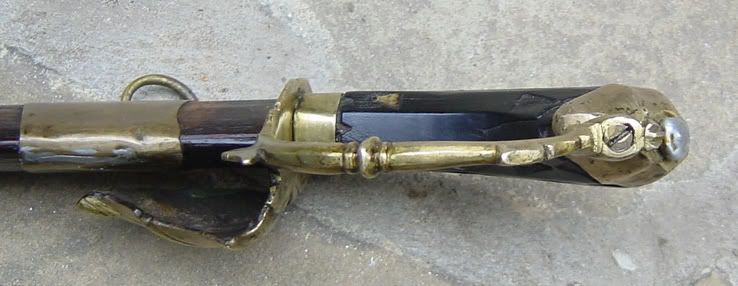     
|
|
|

|
|
|
#19 |
|
Vikingsword Staff
Join Date: Dec 2004
Location: The Aussie Bush
Posts: 4,614
|
The mid-rib on the blade is consistent with a Spanish colonial origin. Probably late 19th C., from the revolutionary period in the Philippines. The full length tang suggests it was made in Luzon, probably Manila.
Ian. |
|
|

|
|
|
#20 |
|
Member
Join Date: Dec 2004
Location: What is still UK
Posts: 5,939
|
Thanks Ian. A revolution period may help explain a some what hurried look about the weapon. The very thickest part of the forte is 7mm. The handle may be horn. Here is a pic of the back. The more I handle it, think I did rather well
 . .  I have been googling the revolution, very interesting. Happy Happy 
|
|
|

|
|
|
#21 |
|
Member
Join Date: Feb 2006
Posts: 637
|
be careful if working with mother of pearl the dust is extreamly hazardous. Must be worked with under a water barrier
|
|
|

|
|
|
#22 |
|
Member
Join Date: Feb 2005
Location: Chicago area
Posts: 327
|
Looks like a couple of inlay are still there. Brass? You should be able to buy a small brass sheet the same thickness & cut new ones.
|
|
|

|
|
|
#23 |
|
Vikingsword Staff
Join Date: Nov 2004
Posts: 6,378
|
Can't wait to see it when you've worked your magic on it Tim .

|
|
|

|
|
|
#24 |
|
Member
Join Date: Dec 2004
Location: What is still UK
Posts: 5,939
|
As two bits of brass foil inlay are left, I will just leave it for now but I will probably add more in the not too distant future. We have found one thing, the inlay does not have to be precious metals or ivory and so on.
|
|
|

|
|
|
#25 |
|
Member
Join Date: Dec 2004
Location: What is still UK
Posts: 5,939
|
hence the small pictures.
|
|
|

|
|
|
#26 | |
|
Vikingsword Staff
Join Date: Nov 2004
Posts: 6,378
|
Quote:
   Beauty Tim ! |
|
|
|

|
|
|
#27 |
|
Member
Join Date: Dec 2004
Location: Italia
Posts: 1,243
|
Well done, Tim! Very nice

|
|
|

|
|
|
#28 |
|
Member
Join Date: Dec 2004
Location: The Netherlands
Posts: 1,209
|
WOOW!!!
Beautiful work Tim!!! Still if i look at the blade, Pedang comes up. Is it a pamor blade, Tim? Philipine origin is possible, but still......... |
|
|

|
|
|
#29 |
|
Member
Join Date: Dec 2004
Location: What is still UK
Posts: 5,939
|
Thanks Henk, easy when you have rolling mills. It looks better now that the glue has set. I have been able to dent and mark the inlay a little, I will show latter when I have time. As to the blade, I cannot tell the difference between fancy folded steel or folded up steel from what ever came to hand or pamor. Judging by the lack of fine finishing, polishing and so on. That and the rather crude screw in the bow I just assumed it was "Indios" rural production?
|
|
|

|
|
|
#30 |
|
Member
Join Date: Feb 2005
Location: Chicago area
Posts: 327
|
Nice. I'm impressed, the type of work that should be done on these old blades. Restoration & not artistic licence to embellish.
|
|
|

|
 |
| Thread Tools | Search this Thread |
| Display Modes | |
|
|